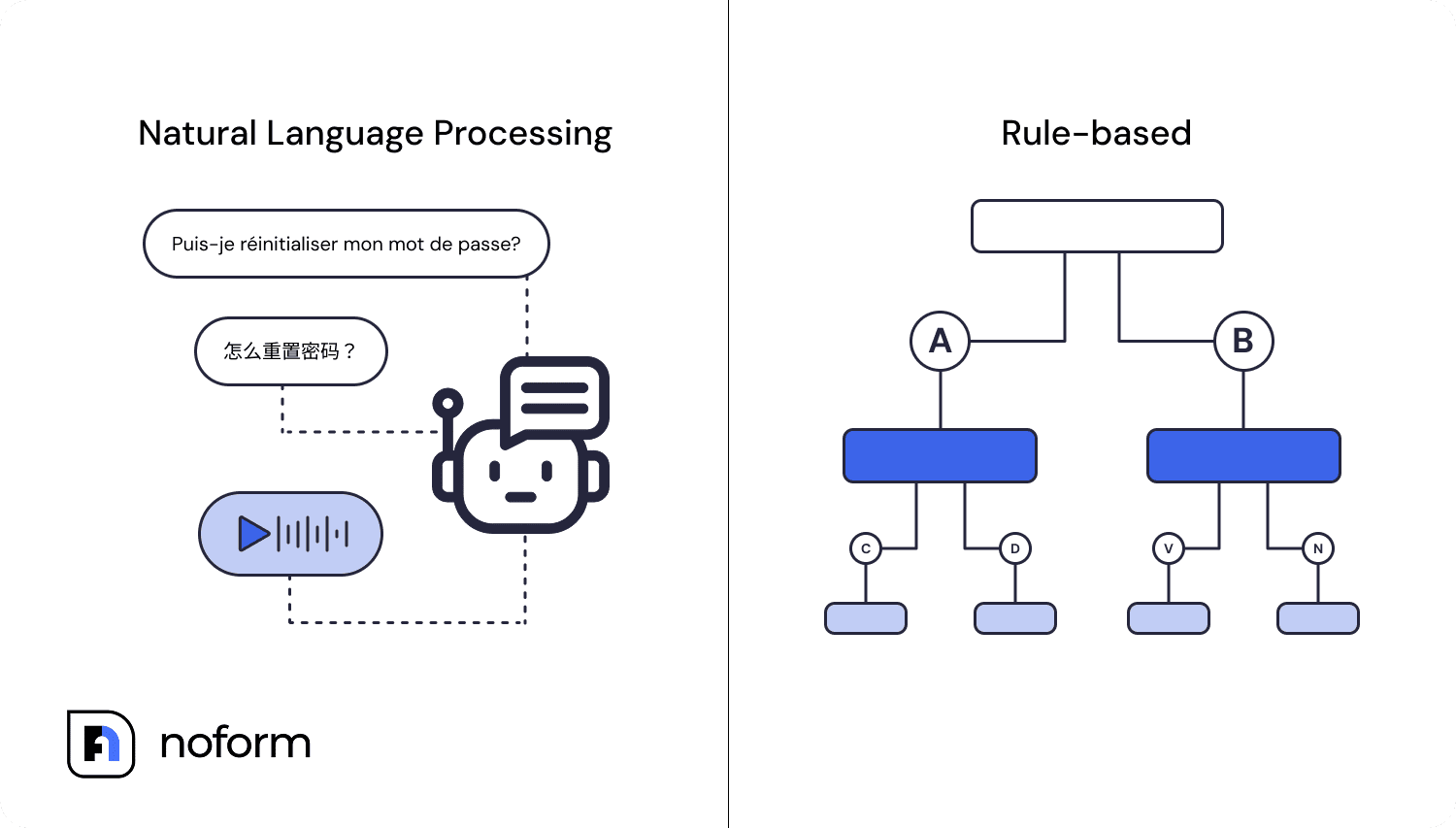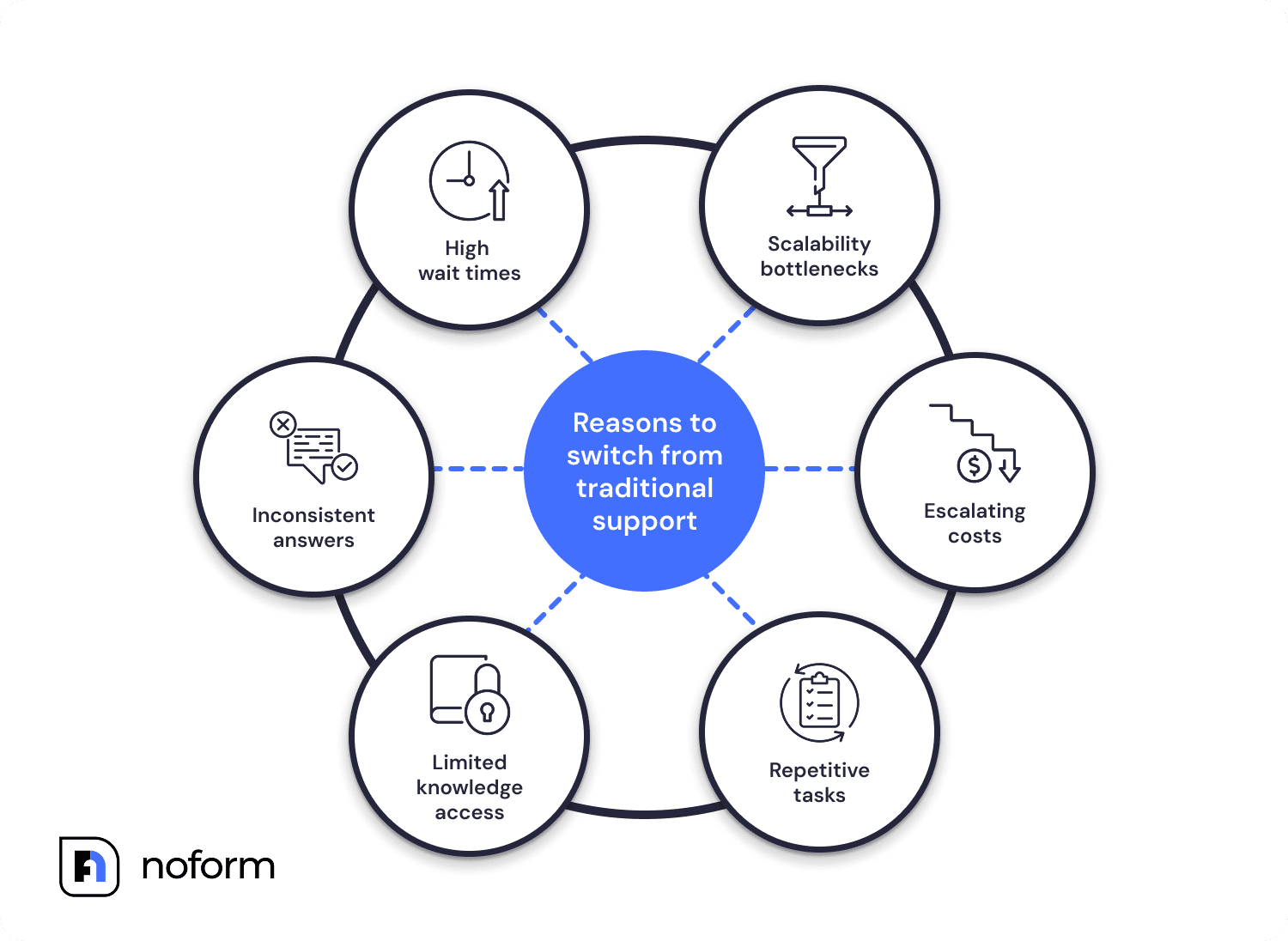What is an NLP Chatbot? Definition, Benefits, Use Cases for NLP Chatbots in 2025
Home » What is an NLP Chatbot? Definition, Benefits, Use Cases for NLP Chatbots
The rule-based chatbot is obsolete. In its place stands the NLP chatbot—a leap from rigid scripts to intelligent, context-aware conversations. Powered by AI, these bots understand intent, adapt in real time, and respond like a human would (minus the hold music).
While most teams still think of chatbots as FAQ machines, many businesses are already relying on natural language processing behind the scenes—whether it’s routing support tickets, qualifying leads, or personalizing replies in live chat. The tech has changed. Quietly, but radically. And if your customer experience still runs on canned responses, it’s time to rethink the strategy.
Here’s what you need to know to catch up—and stay ahead.
What is an NLP chatbot and why it matters
An NLP chatbot is a chatbot using natural language processing (NLP) to understand, process, and respond to human language in a way that feels… well, human.
Unlike old-school bots locked into rigid scripts, NLP chatbots use deep learning models to interpret intent, extract meaning, and generate responses that fit the context—even when users throw in typos or use odd phrasing, slang, or incomplete sentences.
Powered by a stack of AI technologies like natural language understanding (NLU), natural language generation (NLG), and speech recognition, NLP bots have the flexibility to handle open-ended, human-like conversations without derailing.
Whether a user types “how can I return an order?” or says, “hey, I need help with your return policy,” an NLP-based chatbot can follow along and respond with something useful, on the spot.
Natural Language Processing chatbots vs rule-based chatbots
Before chatbots evolved, there were clunky site pop-ups with scripted lines like “Hi there! Need help?” For a moment, they felt innovative—and got the job of greeting visitors done. Then came rule-based chatbots, and for a while, they really did change the game.
A rule-based chatbot is a scripted bot built on fixed chat flows. This type of chatbot technology runs on a decision tree: user inputs—like keywords or button clicks—trigger predefined responses. Every reply depends on matching a specific condition. If the input falls outside the expected flow, the bot stalls, loops, or shuts down the conversation entirely.
Back in 2016 or so, this was a breakthrough. Rule-based bots made websites feel more interactive and saved companies from drowning in basic user queries. But in 2025, as more customers expect a human conversation, not just an endless loop of “select an option from the list,” they’re no longer meeting the mark. Here’s why:
- They break easily when users go off-script
- They can’t reference previous interaction history, treating every customer query as if it’s the first time it’s being asked
- They can’t scale effectively when dealing with nuance, emotion, or layered intent
- They deliver a flat, mechanical user experience that users don’t tolerate anymore
That’s where NLP in chatbot technology comes in. Unlike rule-based chatbots, intelligent chatbots don’t wait for exact phrasing. Instead, they use NLP to understand what the user means, no matter how the question is worded. And when conversations go off track, they don’t break—they adapt, like human agents would.

With AI chatbot features like sentiment analysis, personalization, and contextual learning, NLP bots analyze intent, factor in previous interactions, and tailor responses that feel natural and on point.
Feature | Rule-based сhatbots | NLP chatbots |
Understanding | Keyword-dependent | Deep intent recognition using NLP |
Flexibility | Fixed scripts only | Dynamic, natural language conversations |
Learning capability | Zero | Improves with every user interaction |
Setup complexity | Simple (but limited) | Moderate to advanced |
User experience | Rigid and easily broken | Human-like and context-aware |
Supported queries | Only specific, pre-defined ones | Broad range, including ambiguous phrasing |
Industry fit | Limited use cases | Scalable across industries and workflows |
Response customization | One-size-fits-all | Personalized based on user preferences and data |
Handling ambiguity | Poor | High — detects nuance, misspellings, slang |
Multilingual support | Very limited | Strong support via NLP language models |
Traditional support systems are falling behind: Why use NLP chatbots in 2025?
Traditional customer service is stretched thin. Long wait times, inconsistent answers, and repetitive queries frustrate users and slow down critical business processes.
Natural language processing chatbots fix what human-stretched teams can’t. By shifting frontline support to NLP-powered AI agents, companies scale faster, respond smarter, and reduce costs—without tanking user experience.
Here’s what still goes wrong, and why managers of companies are turning to chatbots using NLP:
- High wait times: 66% of customers expect a response within 5 minutes. Any longer, and churn risk spikes. Natural language chatbots reply instantly, 24/7.
- Inconsistent answers: Human agents vary from one interaction to the next. A well-trained NLP bot delivers consistent, reliable, and fully on-brand responses every time.
- Limited knowledge access: Agents can’t recall every detail. AI NLP chatbots can search massive internal databases in seconds, instantly providing customers with an accurate response.
- Repetitive tasks waste human time: 70% of support conversations are routine—password resets, order updates, and FAQs. AI-powered chatbots handle them all without breaking a sweat, saving businesses up to 2.5 billion working hours.
- Escalating costs: Hiring and training agents is expensive. IBM estimates NLP chatbots can save up to 30% in support costs.
Scalability bottlenecks: Human teams can’t talk to 1,000 people at once, but for NLP bots high request volumes aren’t a problem. Some handle up to 90% of incoming queries alone.

With nearly 1 billion people already interacting with AI chatbots (and 25% of companies planning to make them central to their support strategies by 2027) the shift is already in full-swing. Conversational AI chatbots are quickly becoming the smarter, faster, cheaper backbone of modern customer service.
The technology behind NLP chatbots
You don’t need to be an engineer to understand how chatbots and natural language processing technology work. But if you’re evaluating one for your business, it helps to know what’s under the hood.
Core building blocks of NLP chatbots
At the heart of every smart chatbot are NLP technologies, the foundational systems that enable it to understand, interpret, and respond like a human.
Natural Language Understanding (NLU): Getting context right
This is how the bot understands user input. It involves:
- Lexical analysis: Breaking text into parts (verbs, nouns, etc.)
- Syntactic analysis: Understanding grammar and structure
- Semantic analysis: Interpreting meaning
- Pragmatic analysis: Detecting intent, tone, and implied context
This layered process helps the bot form a deep understanding of every message.
Intent recognition and entity extraction
The bot identifies what the user wants (intent) and what key info they’ve provided (entities).
For example: “What’s your return policy for electronics?” → Intent: ask about return policy; Entity: product category (electronics).
This makes replies accurate and relevant from the first message.
Contextual memory
Unlike rule-based bots, NLP chatbots track conversations with users over time. If someone says, “That last one didn’t work,” the bot knows what “last one” refers to. This enables fluid, human conversation threads.
Natural Language Generation (NLG)
Once the chatbot with NLP understands the input, generative AI modules turn data into a natural reply to create a personal, responsive conversational experience.
What happens when a user sends a message?
Here’s how a typical NLP chatbot processes a message—step by step:
- Input normalization: The bot cleans up the text by lowercasing it, removing extra spaces or odd characters.
- Tokenization: It splits the sentence into smaller parts (called tokens) to analyze structure and meaning.
- Intent recognition: Using machine learning, the bot identifies what the user wants.
- Entity extraction: It picks out key info like names, IDs, dates, or product details.
- Context check: It references the ongoing conversation to maintain flow and avoid repeating questions.
- Response generation: Based on everything above, it crafts a reply that fits.

The business impact of NLP chatbots
By combining natural language processing, machine learning, and real-time context handling, NLP chatbots use AI to power a new standard in business operations across a wide range of industries from SaaS to logistics to e-commerce.
Here’s how they’re making a measurable difference.
Customer engagement
Customer engagement starts with availability and ends with relevance. AI chatbots that use natural language deliver both: responding 24/7, eliminating friction, and guiding users toward what matters.
Unlike static pages or forms, a chatbot with NLP initiates and maintains personalized customer interactions that feel seamless and human. Beyond reactively answering questions, they proactively direct the conversation flow, surface useful content, offer suggestions, and tailor replies based on user behavior and previous inputs.
Cheqmark put this into practice with NoForm AI. After adding an NLP-powered assistant to help users find checklist templates faster, the platform saw a 67% increase in unique page views, 90% more clicks, and 56% higher homepage traffic.
The chatbot didn’t just support users—it kept them engaged, exploring, and converting!
Lead generation & qualification
Stronger customer engagement sets the stage for better lead generation. While a user explores your site, an AI agent can step in, spark a conversation, and guide them toward conversion without waiting for them to make the first move.
From the first visit, the chatbot greets the user and, using natural language and intent recognition, asks focused questions: what they’re looking for, their role, company size, or pain points. It interprets the responses in real time to qualify the lead.
If the visitor is sales-ready, the bot can collect contact info, qualify them based on preset criteria, and route them directly to your team. If they’re not quite there yet, it can keep the conversation going—answering additional questions, offering resources, and capturing useful details for future follow-up.
As a result, by using these types of chatbot built for lead generation and qualification, you don’t just grow your pipeline but improve its quality by filling it with the right leads.
Sales enablement
Chatbot NLP tools streamline early sales interactions with speed and precision, supporting human communication at scale and freeing reps to focus on closing. In fact, 35% of business leaders say Artificial Intelligence-powered chatbots have helped them close deals—delivering conversion lifts of up to 67%.
Here’s how chat bot NLP tools help:
- Qualify leads instantly using targeted questions on needs, timelines, and budget ranges
- Handle objections, responding to common concerns about pricing, features, or implementation (ideal for selling complex solutions)
- Capture and organize lead data for smarter follow-up
- Stay active 24/7, reducing delays that lead to drop-off
- Lower CAC through automation
Dog Gone Taxi is a great example. After implementing NoForm AI’s chatbot to guide users through the booking flow and answer common questions, they saw a 37% increase in visitor-to-lead conversion—just by making the process smoother and faster for potential customers.
Operations & support
Repetitive tickets, missed inquiries, inefficient workflows—NLP bots solve all three. For ops teams, they mean fewer escalations, less manual entry, and lower support overhead. For users, they mean faster answers and better customer satisfaction.
Dog Gone Taxi again provides a perfect use case. Their AI chatbot handled over 1,100 conversations and 3,300 queries, automating support without sacrificing quality. This allowed them to cut two roles—reception and data entry—while providing instant, round-the-clock assistance.

Insights & analytics
Beyond conversations, chatbot natural language processing systems quietly gather data that matters—trends in user intent, feedback on services, drop-off points, and friction moments in the journey.
This insight doesn’t just live in a dashboard. It feeds back into operations, product, and marketing campaigns to help teams make better, faster decisions.
Scalability & reach
The beauty of NLP for chatbots is that they don’t slow down as volume grows. Need to handle 10,000 conversations this week? No problem. Want every one of those interactions to feel personal and localized—even in different languages? Also possible.
With NLP chatbots, you stay focused on your business goals while the tech keeps pace effortlessly.
Unique challenges (and how today’s NLP chatbots overcome them)
Human language is unpredictable—and so is business. From decoding intent to meeting compliance standards, NLP chatbots must navigate more than just text. Powered by large language models and integrated into modern backend systems, today’s bots are designed to manage real-world complexity.
Here’s how:
- Tone, intent, slang, and ambiguity: Users don’t speak in clean commands. NLP chatbots apply advanced parsing and contextual memory to interpret meaning, maintain clarity, and respond with a human touch.
- Multilingual, global use: Businesses serve diverse audiences. These bots deliver seamless communication across languages and regions without duplicating workflows.
- Scalability and learning: High query volume can strain rigid systems. NLP chatbots improve performance over time, learning from interactions without constant manual updates.
- User trust and resistance: Skepticism toward bots is real with people frowning upon roboting replies. Well-built NLP chatbots deliver faster, more relevant answers—closing the gap between automation and human interaction, and increasing adoption across industries.
- Data privacy & compliance: As usage grows, so do risks. Leading chatbot platforms now offer security through encryption, role-based access controls, and region-specific compliance embedded in the chatbot development process.
How to get started with NLP chatbots in your business: Step-by-step guide
You don’t need to be technical—or start from zero—to launch an NLP chatbot that delivers real business results.
Identify areas where customer interaction can be enhanced or automated
Start by identifying where customer interactions are slowing your team down or creating friction for users. Common areas include:
- Overloaded live chats
- Delayed responses
- Form drop-offs
- Missed follow-ups
- High exit rates on product and pricing pages
Dig into support tickets, sales inquiries, CRM logs, and customer feedback to spot recurring questions and bottlenecks. These are the areas where automation can step in, deliver faster responses, and improve consistency without adding headcount.
2. Define clear goals for implementation
Before deploying an NLP chatbot, define what success looks like. For example: aim to reduce chat response time from 10 minutes to 6, increase lead qualification by 25% within the first quarter, or resolve half of repetitive support queries without human involvement in 60 days.
Setting specific benchmarks like these keeps your bot building focused, measurable, and aligned with real business outcomes.
3. Choose the right chatbot platform
You don’t need to build a chatbot from scratch (and let’s be honest, your IT team probably has bigger fires to put out).
One of the most popular choices among professional customers, a ready-made platform like NoForm gives you access to a GPT-4-powered, conversational AI engine trained for seamless customer engagement:
- Secure and compliant: End-to-end encryption for peace of mind.
- Tailored to your business: Trained on your content, not someone else’s.
- No coding needed: Set it up in minutes without touching a single line of code.
- Fully customizable: Adjust behavior, branding, and responses freely.
- Fast deployment: Live in under 3 minutes.

➡️ Learn how to create a chatbot in our guide.
4. Train and deploy your NLP chatbot
Use real, relevant data from your business—help docs, past chats, FAQs, product details, support logs—to train your chatbot.
For effective results, balance quality and quantity of training data: enough to cover core topics without overwhelming the model. As new questions come in, update continuously.
5. Monitor and optimize performance
Once your NLP chatbot is live, set a schedule to check its key performance indicators. Review chat engagement rates and lead conversions to understand how effectively your Al assistant is performing.
Use this insight to tweak tone, tighten flows, or update content to ensure sharper responses, fewer handoffs, better outcomes.
Final thoughts
If you’re serious about scaling support, accelerating sales, or improving the way your team communicates with customers, adopting an NLP chatbot is no longer just a smart move. It’s a necessary one.
But like any powerful tool, it demands clarity, care, and respect for your users’ trust. A secure setup, well-defined goals, and continuous improvement are what make the difference between something that functions—and something that drives real results.
Whether you’re looking to streamline operations, boost conversions, or free your team from repetitive tasks, now’s the time to act.
Build your AI assistant today, or book a live demo to see how NoForm can fit your goals.

